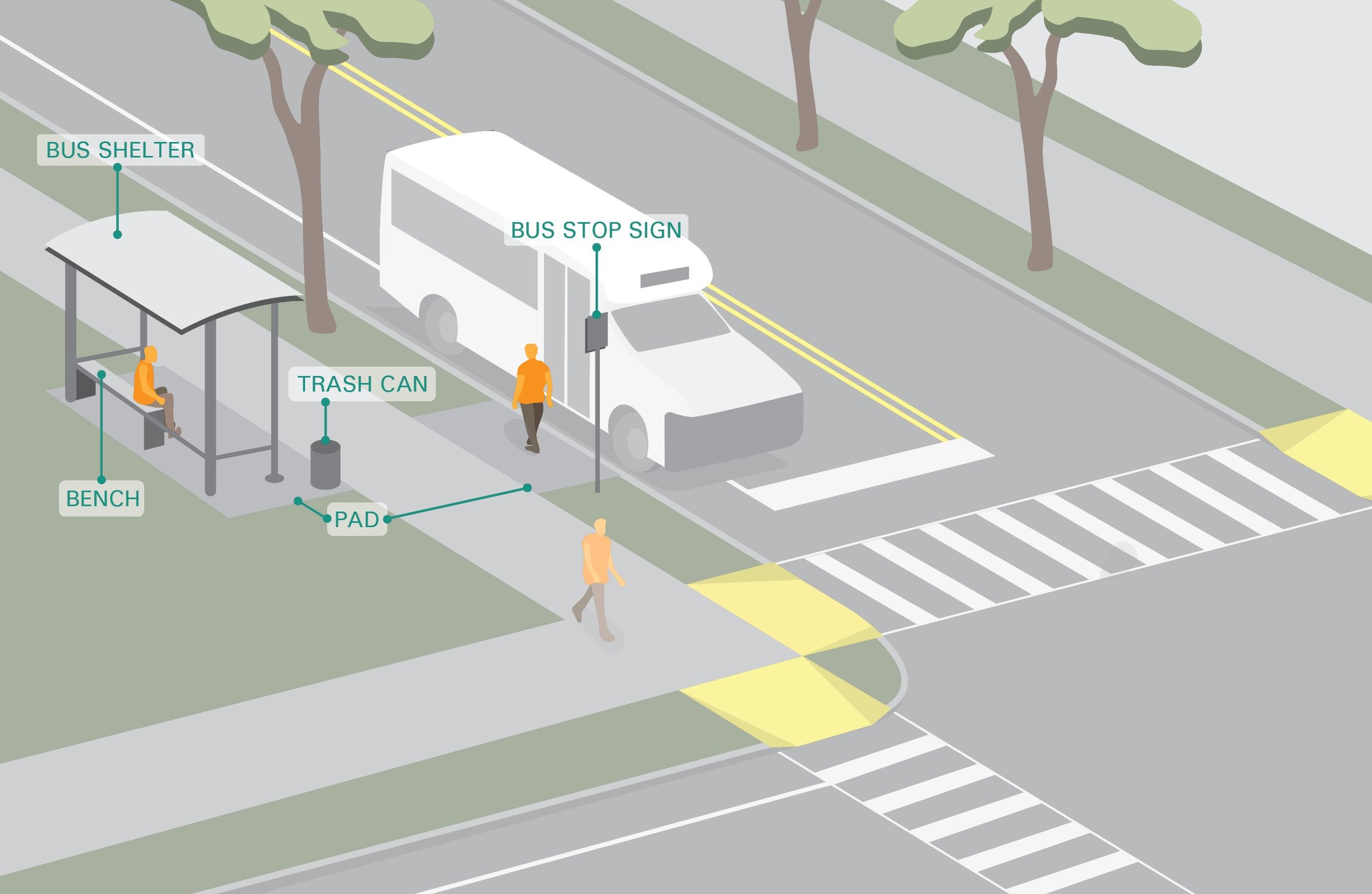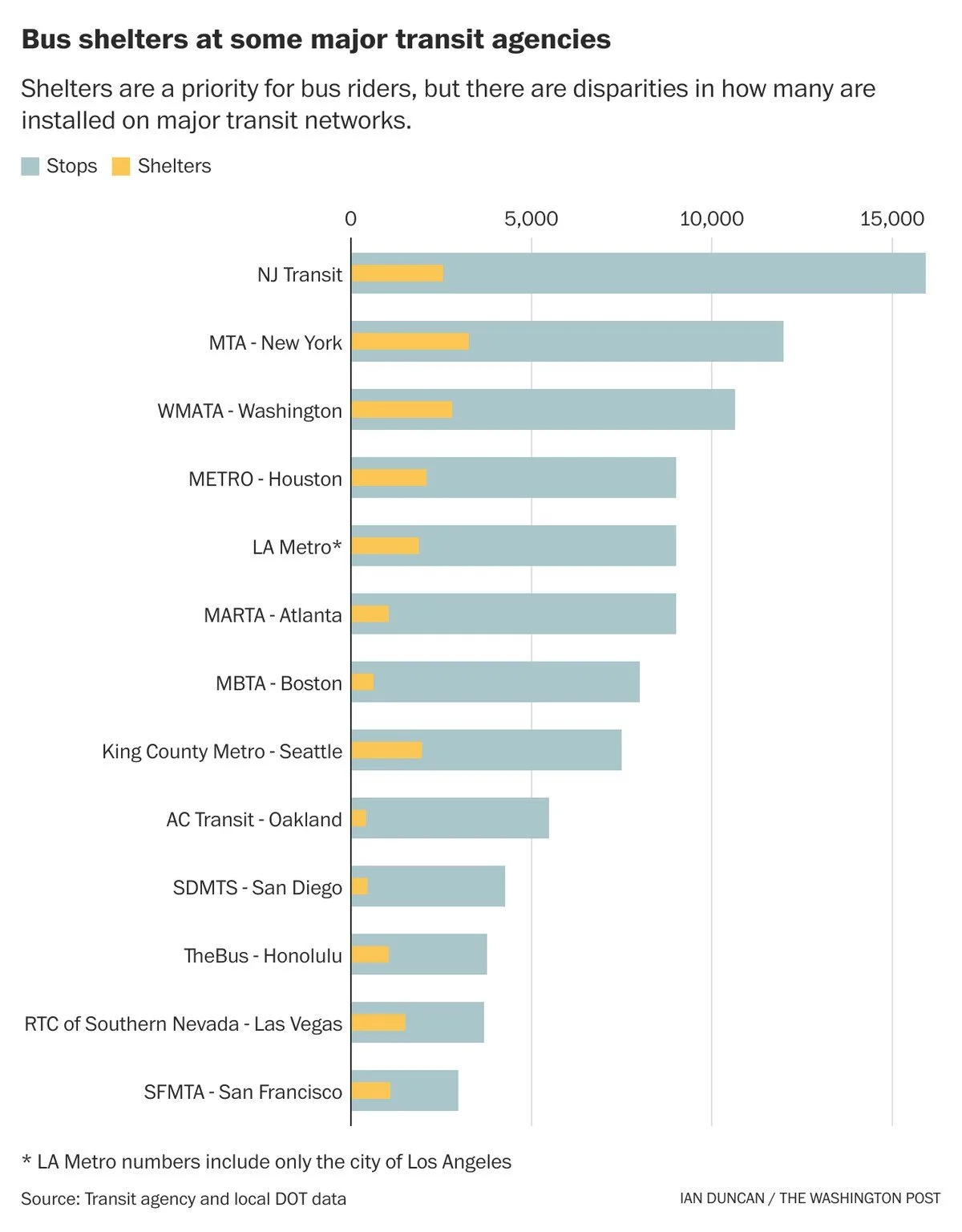Flexible Funding for Transit Access
Flexible Funding for Transit Access
TGC Project example, as featured in The Washington Post, U.S. Department of Transportation
Last year, The Washington Post revealed data highlighting disparities between bus shelters and stops in major transit networks. Author Ian Duncan writes: “As record levels of federal transit funding begin to flow from [2021]’s $1 trillion infrastructure package, plans for thousands of new shelters present a test of whether Washington’s promises to focus on racial equity and the environment can quickly translate into benefits for transit users.”
Source: The Washington Post
Where flex funding comes in
As many large transit agencies plan for more shelters, the U.S. Department of Transportation (USDOT) is seeking to encourage those efforts, helping cities and agencies find ways to tap $350 billion in highway funding, as part of the infrastructure package, towards projects on local streets, including bus shelters.
Numerous TGC clients have benefited from our expertise in this area and funding type. We have leveraged over $100M in flex funding for a variety of transit access improvements and proven safety measures like sidewalks, bicycle lanes, and high-visibility crosswalk enhancements.
Bus Stop Visualization
Source: The Goodman Corporation
Frequently Asked Questions
What is flex funding? Is it a unique source of money for projects?
Source: USDOT
Flex funding is an option that can be exercised with many federal formula funding programs and is not a unique funding stream. Federal law (23 U.S.C. § 104(f); 49 U.S.C. § 5334(i)(1)) allows Federal-Aid Highway Program funding, administered by the Federal Highway Administration (FHWA) and apportioned to State Departments of Transportation, to be flexed (or transferred) to be administered by the Federal Transit Administration (FTA) for public transportation projects, including projects that enhance transit or access to transit. These associated transit improvements must be physically or functionally related to transit facilities. Eligible projects are:
Historic preservation, rehabilitation, and operation of historic public transportation buildings, structures, and facilities (including historic bus and railroad facilities) intended for use in public transportation service.
Bus shelters.
Functional landscaping and streetscaping, including benches, trash receptacles, and streetlights.
Pedestrian access and walkways.
Bicycle access, including bicycle storage shelters and parking facilities and the installation of equipment for transporting bicycles on public transportation vehicles.
Signage.
Enhanced access for persons with disabilities to public transportation.
Why flex funds?
Source: USDOT
Generally, flex funds can streamline project delivery and reduce project costs, particularly for small-scale, low-cost transit access improvements. Exercising the ability to flex funds can provide many advantages:
Promote greater coordination between transit agencies, regions, and municipalities in network design and project planning.
Encourage a more integrated, network-based approach to local and regional mobility.
Reduce the project management burden on State DOTs, particularly for numerous small, distributed projects.
Increase local control and improve context-sensitive design.
Reduce pre-construction design costs.
Accelerate project delivery, especially for smaller infrastructure improvements.
Remove barriers to using Federal-Aid Highway Program funds for pedestrian, bicycle and transit projects and low-cost, distributed safety projects.
Leverage Federal-Aid Highway Program funds to enhance transit access and operation.
Improve the safety and accessibility of the transit network.
How do I start the process to flex funding?
Source: USDOT
Source: USDOT
At TGC, we work closely with our clients and partners to identify smart solutions to community challenges. We translate federal priorities and principles in a way that makes sense to all local stakeholders. We invite the community in and build a robust vision together. While all projects are unique, TGC brings consistent technical and creative excellence to every application and project.
Flex Funding Project Example
TGC Project example, as featured by the U.S. Department of Transportation and referenced in an article by The Washington Post
Bissonnet Pedestrian-Transit Improvements
Location: Houston, TX
Client: Upper Kirby District, Upper Kirby Redevelopment Authority
Consultant: The Goodman Corporation
Timeframe: 2018 – 2019
Source: The Goodman Corporation
Source: The Goodman Corporation
The Upper Kirby Management District (District) and Upper Kirby Redevelopment Authority applied for and received funding for streetscape improvements along a half-mile corridor served by and intersecting multiple fixed-route Houston METRO bus lines. The project included constructing and improving sidewalks, ADA-compliant ramps, crosswalks, pedestrian signals, functional landscaping, and transit-related street furniture.
Transferring funds to FTA allowed the District to implement the project consistent with local design and project delivery processes, while still following all federal requirements related to civil rights, procurement, etc. Managing the project locally led to overall cost and schedule savings compared to going through the full State DOT process, which would have required design standards and processes including detailed environmental analysis that were developed for highway projects.
Following funding, TGC led project implementation through coordination between the District, the City of Houston, Texas Department of Transportation, Federal Transit Administration, and Houston-Galveston Area Council. TGC also managed the administration of construction contracts to include pay application review and approval, review of change orders and submittals, review of quantities, and Davis-Bacon wage rate interviews as compared to certified payroll and prompt payment.
As we look forward to an exciting new year of Connecting Capital to Communities in 2023, we are reflecting on past funding and grant management successes, which has contributed to a solid TGC track record in numerous service areas:
Roadway & Infrastructure Design
Transportation Safety Analysis
Transportation Modeling & Traffic Analysis
Mobility & Transportation Planning
Transit Planning
Community Planning
Economic Development
Environmental
Grant Management, Compliance & Procurement
Construction Administration
Bicycle & Pedestrian Facilities
Intergovernmental Relations & Funding Pursuit
For additional information or questions, contact TGC to learn more about our services, our team, and our mission to connect capital to communities across Texas and beyond.





